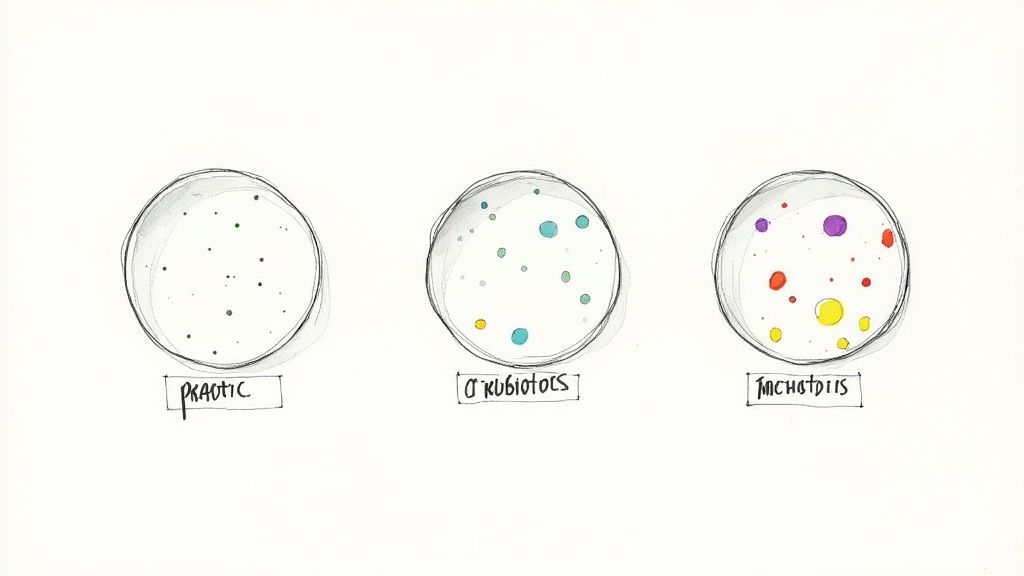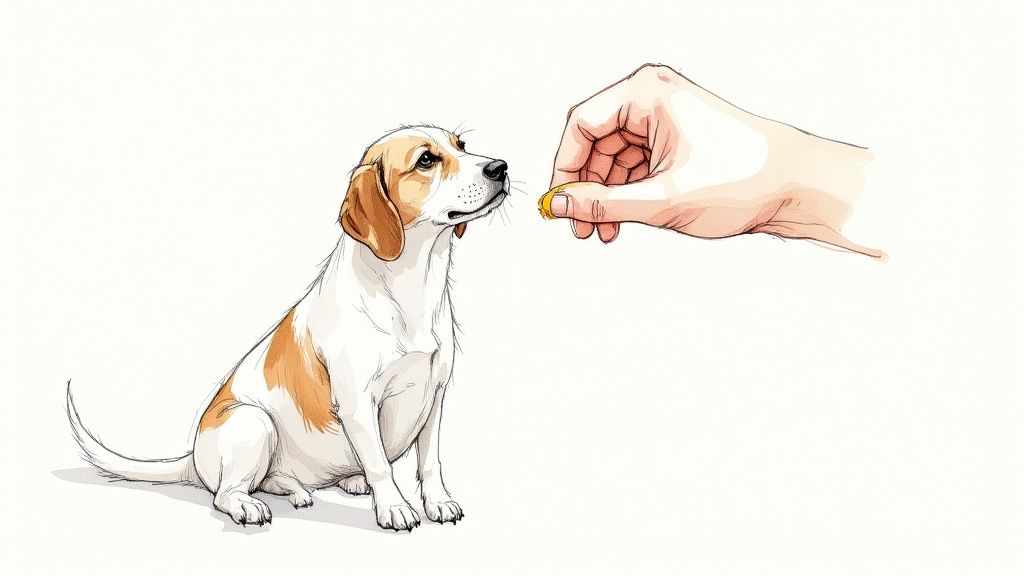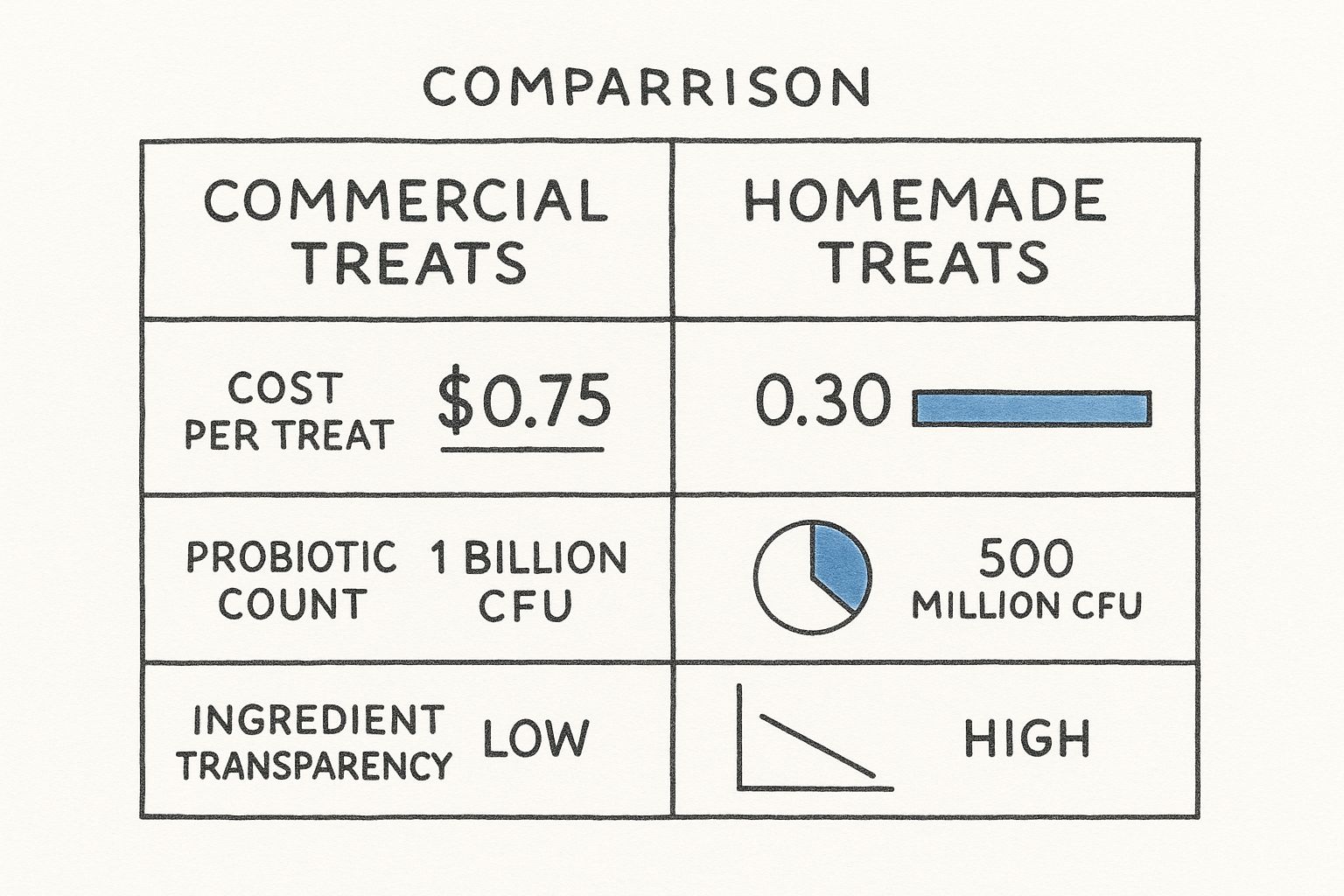We’ve all been there—that pang of worry when you see your dog is clearly uncomfortable, dealing with an upset stomach. It's a feeling almost every pet owner knows well. Probiotic dog treats offer a straightforward and tasty way to support not just their digestive health, but their overall well-being.
Think of your dog's gut as a bustling, intricate garden. For everything to flourish, you need the right balance of 'good bacteria'. Probiotic treats help tend to that garden.
Your Guide to Happier Tummies
We all want our furry companions to feel their absolute best, bursting with energy and free from discomfort. But when their digestive system is out of whack, it can throw everything off, from their mood right down to the health of their coat.
This guide is designed to be your go-to resource, helping you understand how probiotic dog treats can become a valuable part of your dog's daily routine. They're about more than just digestion; they're about promoting genuine vitality.

We'll walk you through everything, from the science behind a healthy canine gut to practical tips on how to confidently choose the best treats for your four-legged friend. This isn't just about putting a stop to the odd tummy ache; it's about making a proactive investment in their long-term health.
What You Will Discover
Inside this guide, we'll break down the essentials into simple, actionable information. You will learn:
- The 'Why' Behind Gut Health: We'll look at the vital role your dog's gut microbiome plays in everything from their immune response to their energy levels and even their behaviour.
- Choosing the Right Treats: You'll get a clear checklist for reading labels, understanding what the ingredients mean, and spotting a high-quality product on the shelf.
- The Real-World Benefits: We'll cover how these treats can lead to noticeable changes like firmer stools, less gas, healthier skin, and a much glossier coat.
- Practical Tips for Use: Find straightforward answers to common questions about how much to give, how often, and when you can realistically expect to see a difference.
Consider this your friendly manual for navigating the world of canine probiotics. Our aim is to give you the confidence and knowledge to make choices that directly contribute to your dog’s lasting health and happiness.
The journey to a healthier gut for your dog starts with a bit of understanding. When you start seeing probiotic treats as more than just a snack—as a functional tool for well-being—you can provide targeted support that helps your companion live a more comfortable and vibrant life. Let's get started.
Why Your Dog's Gut Health Matters
Think of your dog's gut as a bustling community living inside them. This microscopic world, known as the microbiome, is filled with trillions of tiny residents, mostly ‘good bacteria’ that work hard to keep everything running smoothly. They're the unsung heroes of digestion, nutrient absorption, and even immune defence.
But like any community, things can get out of balance. When the ‘bad bacteria’ start to take over, it throws the whole system into chaos. This imbalance, called dysbiosis, is often the root cause of familiar problems like diarrhoea, gas, bloating, and a generally upset tummy. It can even weaken their immune system, making them more susceptible to getting sick.
What throws this delicate ecosystem off? It can be surprisingly common things. A sudden switch in their food, a stressful event like moving house or a trip to the vet, a necessary course of antibiotics, or even just getting older can disrupt the harmony in their gut.
The Gut Is the Centre of Wellness
It's easy to dismiss gut health as just being about digestion, but it’s so much more than that. The gut is truly the foundation of your dog’s overall vitality. A happy, balanced microbiome is linked to almost every part of their well-being.
This incredible connection means that looking after their gut can bring about positive changes you might not expect. For example, a healthy gut is crucial for pulling all the essential nutrients out of their food. If their digestive system isn't working at its best, even the most expensive, high-quality dog food won't give them the full benefit.
A dog’s gut health is responsible for more than just digestion; it influences approximately 70% of their immune system. A balanced microbiome acts as a primary line of defence, helping to protect them from pathogens and allergens.
A well-supported gut is the cornerstone of a happy, energetic, and resilient dog. It’s not just about avoiding tummy troubles—it’s about building their health from the inside out.
From Tummy Aches to Total Health
The effects of an imbalanced gut can ripple through your dog’s entire body, showing up in ways you might not immediately connect to their digestion. By restoring that crucial balance, perhaps with something as simple as probiotic dog treats, you can unlock widespread health benefits.
Here’s a snapshot of how a balanced gut helps your dog thrive:
- Enhanced Nutrient Absorption: Good bacteria are experts at breaking down food, making sure your dog gets every last bit of goodness from their meals. This translates directly to more energy and better overall condition.
- Stronger Immune Response: With so much of the immune system housed in the gut, a healthy microbiome helps your dog fight off bugs and bounce back from illness much quicker.
- Improved Skin and Coat: You can often see gut health on the outside. A balanced gut can help calm skin inflammation and allergies, leading to a glossier, healthier coat.
- Better Mood and Behaviour: The 'gut-brain axis' is a real thing—it's a direct communication highway between the gut and the brain. A calm gut can lead to a calmer, happier, and less anxious companion.
Seeing these connections helps you move from simply reacting to problems to proactively supporting their core health. If you'd like to learn more about how these friendly bacteria work, you can explore the relationship between prebiotics and probiotics for dogs in our detailed guide. Making probiotic dog treats a part of their routine is a simple, effective way to help maintain this vital internal balance and support your dog’s long-term wellness.
What Makes Probiotic Treats Different?
When you hear "probiotic dog treats," it's easy to dismiss them as just another biscuit with a fancy label. But these are fundamentally different from your standard dog snacks. Probiotic treats are functional foods, specifically created not just for a wagging tail, but to actively support your dog's long-term health with live, beneficial bacteria.
Let’s put it this way: a regular dog biscuit is like a plain cracker for us—a simple, enjoyable snack. A probiotic treat, on the other hand, is more like a spoonful of high-quality Greek yoghurt. It tastes good, but it's also delivering a dose of active cultures to boost gut health. These aren't just empty calories; they're a clever delivery system for wellness.

Beyond the Biscuit: The Core Ingredients
What really sets probiotic treats apart is what's inside—specifically, carefully selected strains of good bacteria. These are the microscopic heroes working behind the scenes in your dog's digestive tract.
You'll often spot names like Lactobacillus and Bifidobacterium on the ingredients list. Each strain has a specific job, from helping to break down food more effectively to reinforcing the gut lining against nasty pathogens.
- Lactobacillus acidophilus: A very common strain known for helping maintain a healthy bacterial balance and supporting overall digestion.
- Bifidobacterium animalis: This one is particularly good at bolstering the immune system and can be a real help in managing diarrhoea.
These living organisms are the "active ingredient" that makes probiotic dog treats a functional food. It turns a simple moment of reward into a health-boosting activity.
A key difference lies in the promise of live cultures. A genuine probiotic treat guarantees a certain number of living organisms, often measured in Colony Forming Units (CFUs), ensuring the bacteria are alive and kicking when your dog eats them.
Treats Versus Other Probiotic Forms
Probiotics for dogs come in a few different forms, but treats have some unique advantages over powders or capsules. Powders are effective, sure, but they can be messy, and some dogs will simply turn their nose up at food with a new texture or smell. Capsules can be even trickier to get into a fussy pet.
This is where the sheer convenience and appeal of a treat really shines.
| Probiotic Form | Key Advantages | Potential Downsides |
|---|---|---|
| Treats | Simple to give, enjoyable for the dog, doubles as a training reward. | Dosage might be less precise, can contain extra calories. |
| Powders | Easy to mix into meals, dosage can be precisely controlled. | Can be messy, may change the food's taste or texture. |
| Capsules | Highly concentrated, precise dosing, no flavour to put them off. | Can be difficult to administer to picky or resistant dogs. |
A probiotic treat slots seamlessly into your daily routine. It becomes a moment of positive connection and reinforcement, making it a completely stress-free way to support your dog’s health. This approach isn't just about wellness; it's also about strengthening the bond you share. In a similar vein, some owners find other functional snacks help with different issues; you can learn more about calming treats for dogs in our comprehensive guide.
A Growing Trend in Pet Wellness
The move towards functional treats is a clear sign of how our priorities as pet owners have evolved. More than ever, owners across the UK are looking for preventative health solutions and are happy to invest in premium products that offer real, tangible benefits.
This trend is backed by the numbers. The UK pet treats market, which includes products like probiotic dog treats, is a huge and growing sector. Valued at around USD 934.42 million in 2025, it's expected to climb to about USD 1.07 billion by 2030. This growth is fuelled by things like pet humanisation and a much greater awareness of pet nutrition, with online shops for specialised treats expanding rapidly.
Ultimately, choosing a probiotic treat is about making a proactive, informed decision for your dog's health—turning snack time into a powerful wellness ritual.
The Real Benefits of Probiotic Dog Treats
So, what do probiotic dog treats actually do? We can move past the simple idea of them just being "good for the gut." The real benefits are tangible health improvements that can genuinely boost your dog's quality of life.
Think of these treats not just as a fix for problems, but as building blocks for a happier, more resilient companion. By giving them a simple daily treat packed with beneficial bacteria, you're actively supporting their internal ecosystem. That support ripples outwards, affecting everything from their digestion and skin right through to their mood. Let's dig into the specific advantages you're likely to see.

Better Digestion and Nutrient Absorption
At its heart, a healthy gut is an efficient one. When your dog's microbiome is in balance, the good bacteria get to work breaking down their food properly. This unlocks all the vital nutrients, vitamins, and minerals packed inside their meals, meaning they get more goodness from every single bite.
This improved efficiency often leads to more consistent, well-formed stools—a clear sign of a happy digestive system and a bonus for you at clean-up time. It also means less undigested food passing through, which is a common culprit behind uncomfortable gas and bloating.
Think of it like this: a balanced gut is like a team of expert chefs, carefully preparing every ingredient to extract its maximum flavour and nutritional value. An imbalanced gut is more like a rushed kitchen, where much of the goodness ends up wasted.
Relief from Common Tummy Troubles
Nearly every dog owner knows the stress of an unexpected bout of diarrhoea or the worry of constipation. Probiotic dog treats can be a fantastic tool for managing these common issues by restoring a sense of order to the gut.
They help to crowd out the "bad" bacteria that often cause loose stools, while also promoting the regular, healthy bowel movements that prevent your dog from getting backed up. For dogs with particularly sensitive stomachs, this can mean fewer vet trips and a much more predictable daily routine for everyone.
A Stronger Immune System
Here's a fact that surprises many people: approximately 70% of your dog's immune system is located in their gut. This makes their gut microbiome the body's first line of defence against invading pathogens, allergens, and other nasties from the environment.
By reinforcing their population of good bacteria, you're essentially strengthening your dog's natural defences. This can lead to some brilliant outcomes:
- Fewer sick days: A robust immune system is simply better equipped to fight off common illnesses and infections.
- Reduced allergy symptoms: A healthy gut lining helps prevent allergens from getting into the bloodstream, which can calm down skin irritations and other allergic reactions.
- Quicker recovery: If they do get sick, a dog with a strong, gut-based immune system can often bounce back much faster.
This growing awareness among pet owners is driving a huge amount of interest in products that support digestive and immune health. In fact, the UK dog probiotic supplements market is part of a global segment projected to grow from USD 467.3 million in 2024 to an estimated USD 1,067.6 million by 2035. This boom shows a clear trend towards proactive pet wellness. You can find more dog probiotic market trends on Metatech Insights.
Healthier Skin and a Shinier Coat
Often, the signs of a healthy gut are visible on the outside. Skin troubles like itchiness, dryness, and hot spots are frequently linked to an internal imbalance or inflammatory response that starts deep inside the gut.
By promoting a calm and balanced internal environment, probiotics can help reduce the inflammation that triggers many of these skin problems. The result is often a noticeable improvement in your dog's skin and coat—less scratching, fewer flare-ups, and a beautiful, glossy sheen that really shows off their inner health.
How to Choose the Right Probiotic Treats
Walking down the pet food aisle can be a bit overwhelming, can't it? With so many probiotic treats shouting for your attention, it’s tough to know which ones are genuinely good for your dog and which are just clever marketing. The key is to become a savvy label reader, focusing on what really matters for your dog's gut health.
Don't worry, it's easier than it sounds. You just need to know what to look for. Think of it like picking out a healthy snack for yourself – a quick check of a few key details can make all the difference.
Decoding the Ingredient Label
First things first, flip that packet over and have a proper look at the ingredients. You're searching for quality and transparency, not a long list of fillers and artificial nasties you can't pronounce. A top-notch probiotic treat should have a simple, wholesome foundation.
Here’s what you want to see:
- Whole Foods Up Front: Ingredients like pumpkin, sweet potato, or lean meats should be at the top of the list.
- No Nasty Fillers: Steer clear of treats packed with corn, wheat, soy, or artificial colours and flavours. These can sometimes make digestive problems worse.
- Named Probiotic Strains: The label needs to be specific. Look for named bacteria like Lactobacillus acidophilus or Bifidobacterium animalis. If it just says "probiotic blend," that's a bit of a red flag.
Understanding CFUs and Live Cultures
Next up, let's talk potency. The power of a probiotic treat is measured in Colony Forming Units (CFUs). This fancy term just refers to the number of live, active bacteria in each serving. Think of CFUs as the size of the "good guy" army you're sending into your dog’s gut.
Now, a bigger number isn't always the only goal, but you do need enough for them to actually do their job. Look for treats that guarantee a certain number of CFUs, usually in the billions. A guarantee that holds until the "best before" date is even better, as it means the bacteria are still alive and kicking when your dog gets them.
When a product guarantees "live cultures" or states a clear CFU count, it shows the company is confident in what they've made. Without that, you're flying blind, unsure if you're giving your dog an effective dose.
Choosing Treats for Your Dog's Needs
Finally, think about your own dog. Their size, age, and any specific dietary needs all play a role in finding the perfect treat. A massive Great Dane obviously has different needs to a tiny Jack Russell puppy, so pick something that’s the right size and formulation.
This is especially crucial if your dog has sensitivities. If you know they have a grain allergy, for example, then a grain-free treat is a must. By making sure the treat fits in with their overall diet, you're supporting their health without accidentally causing other problems. For a reliable option designed with these things in mind, you might want to look into products like our digestive probiotics dog supplement.
To help you decide, here’s a quick rundown of some key features to compare when you're shopping around.
Comparing Probiotic Dog Treat Features
| Feature to Check | What to Look For | Why It Matters |
|---|---|---|
| Probiotic Strains | Specific, named strains (e.g., Lactobacillus) on the label. | Vague terms like "probiotic blend" don't tell you what you're actually getting. |
| CFU Count | A guaranteed number, preferably in the billions, valid until the "best before" date. | This ensures the treat contains enough live bacteria to be effective. |
| Core Ingredients | Whole foods like pumpkin, lean meats, or sweet potato listed first. | This shows the treat has a healthy, nutritious base rather than being full of fillers. |
| Allergens & Fillers | Avoidance of corn, wheat, soy, and artificial additives. | These ingredients can irritate a sensitive stomach and offer little nutritional value. |
| Suitability | Options for different life stages (puppy, adult, senior) and dog sizes. | Ensures the treat meets your dog's specific caloric and nutritional requirements. |
Thinking through these points will help you filter out the noise and find a high-quality treat that genuinely supports your dog's well-being.

As you can see, there's a bit of a trade-off. While homemade treats give you total control over ingredients, a well-made commercial treat often delivers a more reliable and powerful dose of probiotics.
This focus on quality and effectiveness is why the market is booming. The UK pet probiotics market is expected to grow at a compound annual growth rate of 7.5% between 2025 and 2035—the fastest growth among key regions. It just goes to show how many of us are demanding better, healthier products for our pets.
Got Questions About Probiotic Treats? We’ve Got Answers.
Stepping into the world of probiotic treats for your dog is bound to bring up a few questions. That’s perfectly normal—when it comes to our furry friends, we all want to get it right. To make things simple, we’ve gathered the most common queries from pet owners just like you and answered them straight.
Think of this as your go-to guide for getting started. We’ll cover everything from how many treats to give your dog each day to when you can realistically expect to see a difference. Let's clear up any confusion so you can feel confident you’re making a great choice for your companion's health.
How Many Probiotic Treats Should I Give My Dog Each Day?
Figuring out the right number of probiotic treats isn't a one-size-fits-all deal. The sweet spot depends on your dog's size, what they’re already eating, and the specific treat you've chosen. The best place to start is always the feeding guide on the packet.
Manufacturers calculate these recommendations carefully to make sure your dog gets an effective dose of probiotics without piling on too many extra calories. A tiny Chihuahua might only need one treat, while a big German Shepherd might need two or three to get the same gut-boosting benefits.
Here’s a solid rule of thumb: treats of any kind, including these helpful ones, shouldn’t make up more than 10% of your dog’s total daily calories. This ensures their proper meals are still their main source of balanced nutrition.
Sticking to the suggested amount is key. While an extra treat here and there won't hurt, consistently overdoing it could lead to unwanted weight gain or even a bit of temporary digestive upset. When it comes to probiotics, consistency is much more important than quantity.
Can Puppies Have Probiotic Dog Treats?
Yes, they absolutely can! In fact, giving puppies probiotic treats can be a fantastic way to support their developing digestive and immune systems. Introducing good bacteria early on helps build a strong foundation for their health down the line.
That said, it’s best to choose products made specifically for puppies. Their little systems are still maturing and can be quite sensitive. Look for treats that are the right size for smaller mouths to avoid any choking risks. You’ll also want a gentle formula, free from any harsh ingredients or fillers that could upset a delicate puppy tummy.
Before you start, it’s always a brilliant idea to have a quick chat with your vet. They can offer advice tailored to your puppy's breed, size, and health, making sure you're supporting their growth in the safest and most effective way.
Are There Any Potential Side Effects?
When you first introduce probiotic treats, you might notice a few minor, temporary tummy changes. Don't panic! This is usually just a sign that your dog's gut is adjusting to all the new, friendly bacteria setting up shop. Think of it as a bit of internal reorganisation.
For a few days, you might see some mild signs like:
- A bit more gas than usual
- Slightly looser or firmer poos
- A few gurgling noises from their belly
These effects are typically short-lived and should disappear on their own as their gut settles into a new, healthier balance. If the symptoms carry on for more than a week, or if your dog seems genuinely uncomfortable, it’s best to stop giving the treats and check in with your vet. This is quite rare, but it's always better to be on the safe side.
How Long Does It Take to See Results?
Patience is your best friend here. The benefits of probiotics don't happen overnight; they build up as the good bacteria get established in the gut. While you won't see a dramatic change in 24 hours, you should start noticing positive shifts within a few weeks of consistent, daily use.
The exact timeline really depends on your dog and what you’re hoping to improve. For general digestive wellness, like firmer stools or less wind, you could see a difference in as little as one to two weeks.
For deeper-seated issues, like improving skin health or boosting their immune response, it might take a bit longer—perhaps four to six weeks—for the benefits to become really obvious. The trick is to be consistent. A daily treat allows the beneficial bacteria to properly colonise the gut and get to work. Stick with it, and you'll be well on your way to seeing a happier, healthier pup.
At Tipaw, we're dedicated to helping dogs live their best lives through natural, effective supplements. Our vet-approved formulas are made with 100% natural ingredients to support your dog's health from the inside out. Discover our range of functional chews and join thousands of happy dog parents across Europe. Learn more about our mission to improve dog wellness at Tipaw Store.





